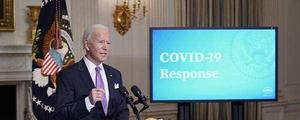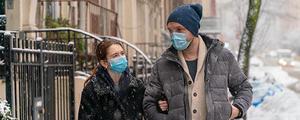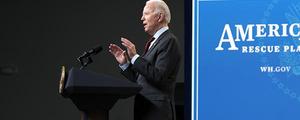Story Highlights
- 60% of Americans report COVID-19 situation is improving, a trend high
- 22% worry about access to COVID-19 tests, down from 60% last April
- Since June, seven in 10 U.S. adults have reported experiencing disruption
WASHINGTON, D.C. -- One year after the COVID-19 pandemic took hold of the U.S., Americans have become markedly more upbeat in their views of the trajectory of the situation, and their worries about access to testing and medical supplies and services have eased. At the same time, Americans' reports of the extent to which the pandemic has disrupted their lives, and their predictions for how long the disruption will last, remain steady.
Six in 10 See COVID-19 Situation as Getting Better
For the first time in Gallup's trend, a majority of Americans (60%) perceive the coronavirus situation in the U.S. as getting better, while 26% say it is staying the same and 14% believe it is getting worse. This record-high optimism likely reflects the steep decline in new COVID-19 cases in the U.S. in late January and early February. Gallup previously documented a strong relationship between changes in COVID infection rates and Americans' assessment of the situation. When the percentage of new COVID-19 cases spiked in the summer and fall, majorities of Americans said the situation was getting worse.
Last April, when Gallup first asked Americans for their views on the COVID-19 situation in the U.S., 56% said it was getting worse, while 29% said it was getting better and 15% said it was staying the same. Through mid-June, roughly four in 10 Americans said the situation was improving, including a then-record high of 47% during the first week of June.

Line graph. Americans' perceptions of the trajectory of the COVID-19 situation. In February 2021, 60% of Americans said the situation was getting a little or a lot better, 26% it was staying the same and 14% a little or a lot worse.
As COVID-19 cases surged throughout June, following a loosening of business closures in several states, Americans became markedly more pessimistic. In late June, for the first time since April, a majority of Americans (65%) said the situation was getting worse. Majorities of Americans would continue to view the situation as getting worse through mid-August, with a peak of 73% saying so as new cases of the disease surged to over 70,000 in one day.
As the number of new cases receded in September, the percentage of Americans reporting the situation as worsening declined as well, falling to 42% -- only to climb again in November, matching the previous peak of 73%. In January of this year, the number of new cases began to fall, as did the percentage saying the situation was worsening, to 39%. Americans' optimism further improved in the February poll, as new cases continued to decline nationwide.
Worry About Access to COVID-19 Tests, Medical Supplies Has Waned
Last April, worry about access to COVID-19 tests, as well as medical supplies and services, was widespread. At that time, 60% of Americans were very or moderately worried about the availability of COVID-19 tests, and 64% were very or moderately worried about the availability of hospital supplies, services and treatment in their area. As they isolated in an effort to "flatten the curve" and slow the rate of infection, Americans' concern about access to COVID-19 tests and medical supplies and services declined. By mid-June, 33% of Americans worried about access to COVID-19 tests, and 34% worried about access to medical supplies and services. However, as cases climbed again, so did concern, with roughly four in 10 Americans registering worry about both through August of last year.
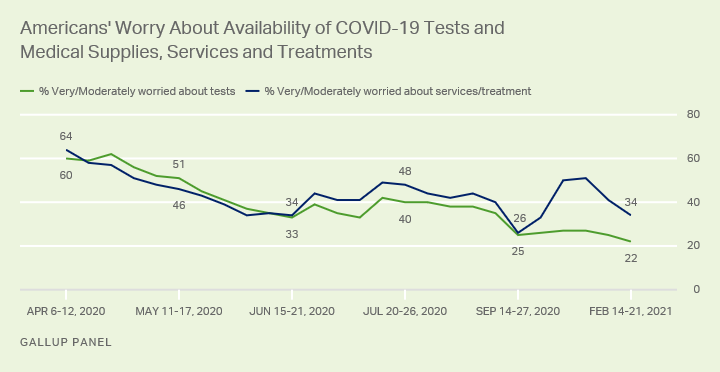
Line graph. Americans' worries about the availability of COVID-19 tests, as well as hospital supplies, services and treatments. In February 2021, 22% of Americans were very or moderately worried about the availability of tests, while 34% were very or moderately worried about the availability of hospital supplies, services and treatments.
Late last summer, the Trump administration announced plans to deploy 150 million rapid tests in 2020, likely alleviating some public fear about access to testing, as well as to medical supplies and treatment. From August to September, the percentage of Americans worried about access to testing fell from 35% to 25%, roughly where it remained through the end of January.
Worry about access to medical supplies and treatment also dropped between August and September, from 40% to 26%. It quickly resurged, however -- hitting 51% in late December, only to gradually fall to 34% by February, in line with the rate of new COVID-19 infections.
Views on COVID-Related Disruption Steady Since June
Gallup first asked Americans to assess the level of disruption in their lives due to the COVID-19 situation in mid-March of last year. At that time, 56% of the U.S. public said the pandemic had caused a "great deal" or "fair amount" of disruption. The percentage of Americans saying their lives had been disrupted by the disease peaked at 81% in late March/early April, shortly after President Donald Trump declared the COVID-19 pandemic a national emergency. Around the same time, Trump endorsed a 15-day plan of aggressive social distancing and self-quarantining throughout the U.S. to "flatten the curve" of COVID-19 infections, potentially further increasing Americans' sense of disruption in their lives.
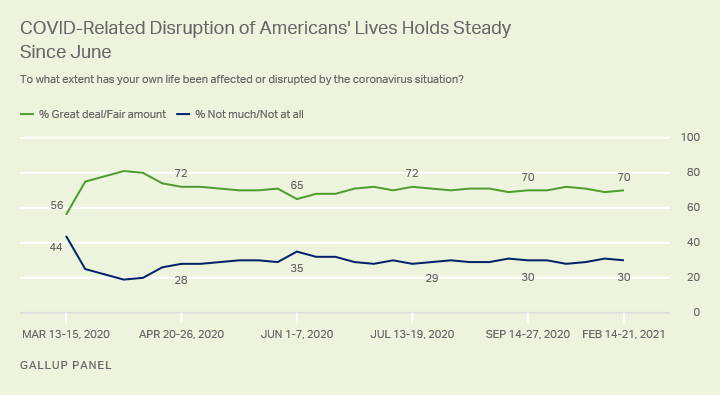
Line graph. Americans' perceptions of disruption in their lives due to the COVID-19 pandemic. In February 2021, 70% of Americans said their lives had been disrupted a great deal or fair amount, while 30% said their lives either had not been disrupted or not much at all.
The original 15-day period would eventually be extended through April 30, when Trump allowed the federal stay-at-home guidelines to expire. However, many states maintained partial or complete stay-at-home orders through May.
The percentage of Americans reporting a great deal or fair amount of personal disruption stayed near 70% throughout this period. In May, many states began to reopen, causing perceptions of disruption to dip to 65% in early June. COVID-19 cases began to spike later that month, causing many states to pause their plans to reopen -- and by late June, 71% of Americans were again reporting a great deal or fair amount of disruption in their lives. Perceptions remained at this level through February of this year.
Views on Disruption's Duration Hold Steady in Recent Months
Since mid-March of last year, Gallup has asked Americans for their views on how long the disruption related to COVID-19 will last. At that time, 50% predicted it would last a few more months and 37% a few more weeks, while 9% thought it would persist the rest of the year and 4% into 2021.
As the pandemic wore on, Americans' assessment of the projected length of the disruption shifted, with more saying it would last through 2020 or beyond. In late June, with many states reversing their plans to reopen, a solid majority believed the disruption would last through the end of the year (37%) or longer (37%). Increasing percentages of Americans said they expected the disruption from the pandemic to last "longer than this year," reaching the majority level (51%) for the first time in mid-August.
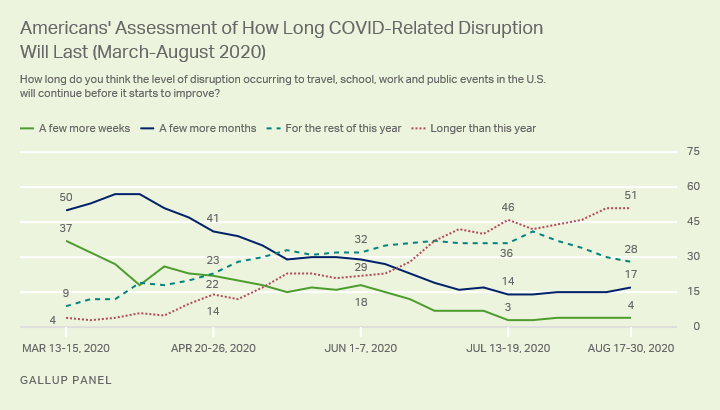
Line graph. Americans perceptions of how long the COVID-19 pandemic will last from March 2020 through August 2020. At the end of August, 51% of Americans said it would last longer than 2020, 28% the rest of the year, 17% a few more months and 4% a few more weeks.
In September, Gallup changed the categories for this pandemic outlook question, allowing respondents to choose "through the first half of 2021" or "longer than that," in addition to "a few more weeks" and "a few more months."
At that time, 5% said the disruption would last a few more weeks, 23% a few more months, 46% through the first half of 2021 and 26% longer than that. Although the U.S. Food and Drug Administration issued emergency use authorization for the first COVID-19 vaccine in December, Americans became more pessimistic about the expected length of the disruption. The percentage saying pandemic-related disruptions would last longer than mid-2021 rose from 33% in December to 53% in January, and remained at the same level in February.
| A few more weeks | A few more months | Through the first half of 2021 | Longer than that | ||||||||||||||||||||||||||||||||||||||||||||||||||||||||||||||||||||||||||||||||||||||||||||||||
|---|---|---|---|---|---|---|---|---|---|---|---|---|---|---|---|---|---|---|---|---|---|---|---|---|---|---|---|---|---|---|---|---|---|---|---|---|---|---|---|---|---|---|---|---|---|---|---|---|---|---|---|---|---|---|---|---|---|---|---|---|---|---|---|---|---|---|---|---|---|---|---|---|---|---|---|---|---|---|---|---|---|---|---|---|---|---|---|---|---|---|---|---|---|---|---|---|---|---|---|
| % | % | % | % | ||||||||||||||||||||||||||||||||||||||||||||||||||||||||||||||||||||||||||||||||||||||||||||||||
| Feb 14-21, 2021 | 2 | 8 | 38 | 52 | |||||||||||||||||||||||||||||||||||||||||||||||||||||||||||||||||||||||||||||||||||||||||||||||
| Jan 25-31, 2021 | 2 | 8 | 37 | 53 | |||||||||||||||||||||||||||||||||||||||||||||||||||||||||||||||||||||||||||||||||||||||||||||||
| Dec 15, 2020-Jan 3, 2021 | 2 | 11 | 55 | 33 | |||||||||||||||||||||||||||||||||||||||||||||||||||||||||||||||||||||||||||||||||||||||||||||||
| Nov 16-29, 2020 | 2 | 11 | 56 | 31 | |||||||||||||||||||||||||||||||||||||||||||||||||||||||||||||||||||||||||||||||||||||||||||||||
| Oct 19-Nov 1, 2020 | 9 | 13 | 51 | 28 | |||||||||||||||||||||||||||||||||||||||||||||||||||||||||||||||||||||||||||||||||||||||||||||||
| Sep 14-27, 2020 | 5 | 23 | 46 | 26 | |||||||||||||||||||||||||||||||||||||||||||||||||||||||||||||||||||||||||||||||||||||||||||||||
| Gallup Panel | |||||||||||||||||||||||||||||||||||||||||||||||||||||||||||||||||||||||||||||||||||||||||||||||||||
Bottom Line
Americans' perceptions of personal disruption caused by COVID-19 rose quickly early in the pandemic -- particularly as the federal government issued national guidelines to stay at home in an effort to control its spread. When those guidelines expired, perceptions of disruption largely plateaued, with a slight dip during the brief relaxation of state-level restrictions last June. And, as the pandemic has persisted, Americans have become more pessimistic about how long it will last.
In contrast to their perceptions of personal disruption, Americans' assessment of how the situation is progressing is largely related to the fluctuating number of new cases. Consistent with this pattern, Americans became substantially more optimistic in February after the number of U.S. cases dropped. However, in recent days, that number has stopped declining. This, coupled with potential difficulties with the vaccination program or the rapid spread of new variants of the disease, could result in optimism fading rapidly.
Learn more about how the Gallup Poll Social Series works.

